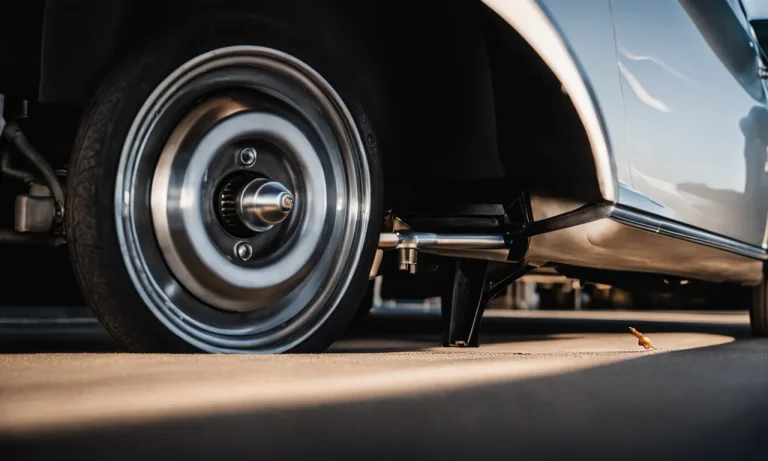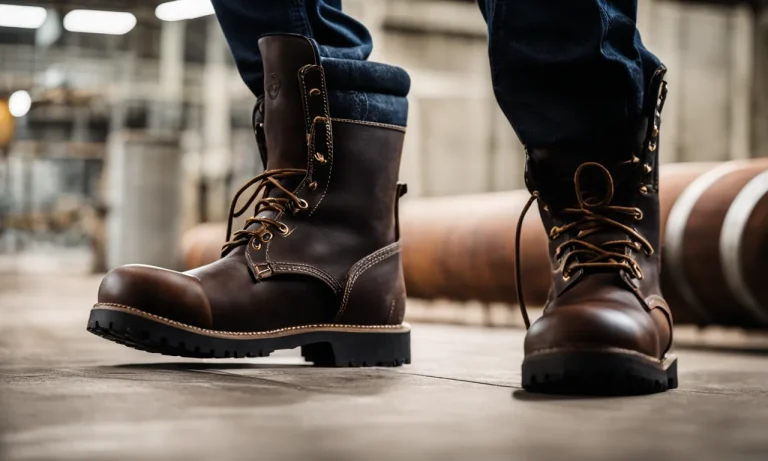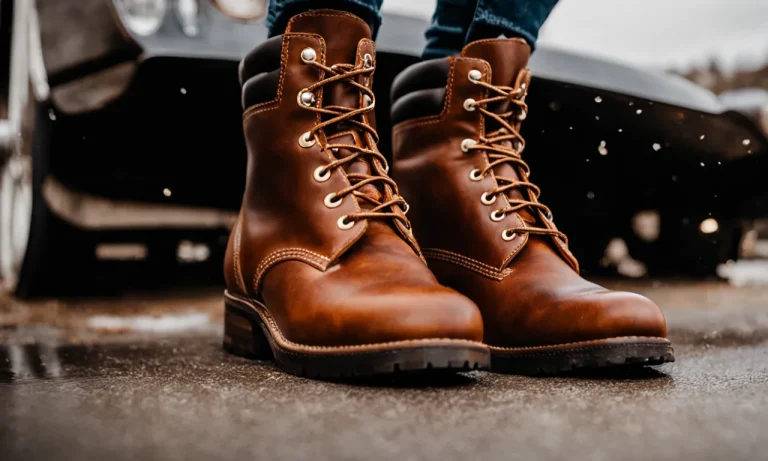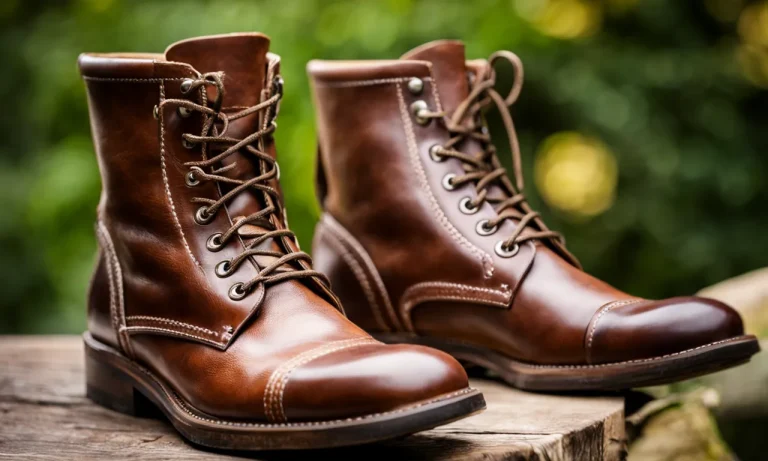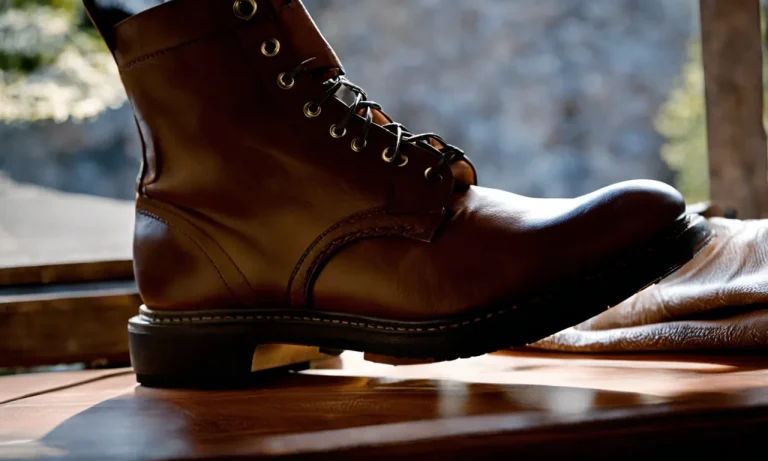Steel toe boots have long been a staple of many work environments, providing an extra layer of protection for the feet against impacts and compression. But there are also concerns around potential risks of wearing steel toes, so it’s understandable if you’re wondering – are steel toe boots safe to wear or not?
If you’re short on time, the quick answer is: yes, steel toe boots are generally safe for most people in workplace settings where foot protection is needed. They are designed to protect the feet and toes from common injuries like falling objects, without major downsides for the average worker.
However, some key things to keep in mind are ensuring proper fit, watching for signs of pressure or discomfort, and being aware of electrical conductivity risks in some industries.
How Steel Toe Boots Protect Your Feet
Steel toe boots are specifically designed to provide protection for the feet in hazardous work environments. They are commonly used in industries such as construction, manufacturing, and warehousing, where the risk of foot injuries is high.
Here are some ways in which steel toe boots offer protection:
Protect Toes from Blunt Impacts
One of the primary functions of steel toe boots is to safeguard the toes from blunt impacts. These boots feature a reinforced steel cap in the toe area, which acts as a shield against heavy objects that may accidentally fall or be dropped on the feet.
The sturdy steel construction can effectively absorb the impact and prevent severe injuries such as fractures or amputations.
According to a study conducted by the National Institute for Occupational Safety and Health (NIOSH), steel toe boots were found to significantly reduce the risk of toe injuries in the workplace. Workers who wore steel toe boots had a lower incidence of toe fractures compared to those who did not.
Shield Against Compression
In addition to protecting against blunt impacts, steel toe boots also provide a defense against compression injuries. These injuries can occur when heavy objects roll over the foot or when machinery or equipment accidentally crushes the feet.
The reinforced steel toe cap helps distribute the weight and pressure evenly, minimizing the risk of severe injuries such as bone fractures or tissue damage.
A study published in the Journal of Occupational and Environmental Hygiene found that steel toe boots were effective in reducing the severity of foot injuries caused by compression forces. Workers who wore steel toe boots had a lower rate of severe foot injuries compared to those who did not.
Reduce Trip and Fall Injuries
Steel toe boots not only protect against external hazards but also play a role in reducing trip and fall injuries. These boots often come with slip-resistant soles, which provide better traction on slippery surfaces.
This feature can help prevent accidental slips and falls, reducing the risk of foot injuries associated with such incidents.
A study conducted by the Occupational Safety and Health Administration (OSHA) found that slip-resistant footwear, including steel toe boots, contributed to a significant decrease in slip and fall accidents in the workplace.
Potential Safety Concerns and Risks
Ill-Fitting Boots Can Cause Discomfort
While steel toe boots are designed to provide protection, it is important to ensure they fit properly. Ill-fitting boots can cause discomfort and even lead to foot problems such as blisters, calluses, and corns.
It is crucial to choose the right size and style of steel toe boots that offer a snug fit without being too tight or too loose. Taking the time to try on different sizes and styles can help prevent unnecessary discomfort and potential foot issues.
May Conduct Electricity
One of the potential risks of steel toe boots is their ability to conduct electricity. In certain work environments where there is a risk of electrical hazards, wearing steel toe boots may not be the safest choice.
When exposed to electrical currents, the steel toe can act as a conductor, increasing the risk of electric shock or injury. In such cases, it is important to consider alternative safety footwear options that are specifically designed to provide electrical hazard protection.
Don’t Protect Against All Hazards
While steel toe boots offer excellent protection against impact and compression hazards, it is important to note that they do not provide comprehensive protection against all types of workplace hazards. For example, they may not protect against puncture wounds or chemical spills.
In industries where there are multiple hazards present, it may be necessary to use additional protective equipment in conjunction with steel toe boots to ensure overall safety. Assessing the specific risks of the work environment and selecting appropriate safety gear is essential for mitigating potential hazards.
Tips for Choosing and Wearing Steel Toes Safely
Get Properly Fitted Boots
When it comes to steel toe boots, getting the right fit is crucial for safety and comfort. Ill-fitting boots can cause discomfort, blisters, and even foot problems in the long run. It’s important to try on different sizes and styles to find the one that fits your feet properly.
Don’t hesitate to consult a knowledgeable salesperson who can guide you in choosing the right size and width for your feet. Remember, a properly fitted boot provides better protection and reduces the risk of accidents.
Inspect for Wear and Tear
Regularly inspecting your steel toe boots for wear and tear is essential for maintaining their safety features. Check for any cracks, holes, or loose material that may compromise the integrity of the boots.
Pay attention to the soles, as worn-out treads can affect traction and increase the risk of slips and falls. If you notice any damage, it’s recommended to replace the boots or have them repaired by a professional. Remember, a well-maintained boot is a safe boot.
Wear with Suitable Socks and Insoles
Choosing the right socks and insoles can significantly enhance the comfort and safety of steel toe boots. Opt for moisture-wicking socks that keep your feet dry, reducing the risk of blisters and foot odor.
Consider using cushioned insoles that provide extra support and shock absorption, reducing the strain on your feet and joints. These additional layers of protection not only improve your overall comfort but also contribute to the longevity of your boots.
Take Breaks and Remove Boots When Possible
Wearing steel toe boots for prolonged periods can lead to fatigue and discomfort. To avoid this, it’s important to take regular breaks and remove your boots when possible, especially during long shifts or physically demanding tasks.
This allows your feet to rest and recover, reducing the risk of strains and injuries. Remember, taking care of your feet is just as important as wearing the right safety footwear.
Choose Alternatives Where Higher Risks Exist
While steel toe boots provide excellent protection in many work environments, there may be situations where alternative safety footwear is more appropriate. For example, if you work in an environment with electrical hazards, it’s advisable to opt for electrical hazard boots that provide insulation against electrical shocks.
Similarly, if your work involves exposure to chemicals or extreme temperatures, selecting specialized boots designed for these conditions is essential. Always assess the specific risks in your workplace and choose the appropriate footwear accordingly.
For more information on workplace safety regulations and guidelines, you can refer to the Occupational Safety and Health Administration (OSHA) website at www.osha.gov.
Types of Steel Toe Boots and Their Safety Features
Standard Steel Toe
Standard steel toe boots are the most common type of safety footwear. They are designed with a steel cap that covers the front of the foot, providing protection against heavy objects and impacts. These boots are durable and can withstand high levels of compression, making them ideal for construction workers, warehouse employees, and other professionals who work in hazardous environments.
Composite Toe
Composite toe boots are an alternative to steel toe boots. Instead of steel, these boots are made with non-metal materials such as fiberglass, carbon fiber, or Kevlar. They offer similar levels of protection but are lighter in weight.
Composite toe boots are a great choice for individuals who work in areas with metal detectors or electrical hazards, as they are non-conductive.
Alloy Toe
Alloy toe boots are another popular option in the safety footwear market. They are made with a combination of lightweight materials like aluminum or titanium, which provide protection without the added weight of steel.
Alloy toe boots are perfect for people who need safety footwear but don’t want the heaviness of traditional steel toe boots.
Metatarsal Guards
Metatarsal guards are additional protective features that can be added to steel toe boots. They cover the metatarsal bones, which are located in the middle of the foot. These guards offer extra protection against impacts and compression, reducing the risk of injuries.
Metatarsal guards are commonly used in industries where heavy machinery or falling objects are a concern.
Puncture-Resistant Soles
Some steel toe boots come with puncture-resistant soles, which provide protection against sharp objects like nails or shards of glass. These soles are typically made with a layer of reinforced material, such as Kevlar or steel, to prevent penetration.
Puncture-resistant soles are especially important for workers in construction, landscaping, and manufacturing industries.
Electrical Hazard Rating
Steel toe boots with an electrical hazard rating are designed to protect the wearer from electrical shocks. They are made with non-conductive materials and have special outsoles that provide insulation against electrical currents.
These boots are essential for workers in electrical and utility industries, as well as anyone who works with live wires or in environments where electrical hazards are present.
Industries and Jobs Where Steel Toes Are Recommended
Construction
One of the primary industries where steel toe boots are highly recommended is construction. Construction sites can be hazardous, with heavy machinery, falling objects, and potential foot injuries from stepping on sharp objects.
Steel toe boots provide a crucial layer of protection for construction workers, reducing the risk of serious foot injuries.
Manufacturing
In the manufacturing industry, steel toe boots are essential for the safety of workers. With heavy equipment, moving parts, and potential exposure to hazardous materials, there is always a risk of foot injuries.
Steel toe boots provide reliable protection against accidental impacts, compression, and punctures, ensuring the safety of those working in manufacturing facilities.
Warehousing
Warehouses are bustling environments with constant movement of goods and heavy machinery. Employees in warehouses face potential risks such as falling objects, forklift accidents, and slips and falls. Steel toe boots are highly recommended in this industry to protect workers’ feet from potential injuries, ensuring their safety while performing their daily tasks.
Automotive Repair
Automotive repair shops are another workplace where steel toe boots are strongly recommended. Mechanics and technicians often handle heavy tools and equipment, work under vehicles, and deal with sharp objects and potential falling objects.
Steel toe boots offer vital protection against these hazards, reducing the risk of foot injuries in automotive repair settings.
Emergency Response
Emergency response personnel, such as firefighters and paramedics, also benefit from wearing steel toe boots. In high-pressure situations, these professionals may encounter debris, sharp objects, or heavy equipment that can cause foot injuries.
Steel toe boots provide an additional layer of safety and protection, allowing emergency response personnel to focus on their life-saving duties.
It’s worth noting that the industries and jobs mentioned above are just a few examples where steel toe boots are recommended. Many other professions, such as mining, logging, and agriculture, also require the use of steel toe boots to ensure the safety and well-being of workers.
Conclusion
In summary, steel toe boots provide meaningful protection against toe and foot injuries when worn in appropriate occupational settings. While ill-fitting boots or certain hazards like electricity require caution, steel toes have withstood the test of time as practical protective footwear for workers in many manual labor jobs and industrial environments where heavy or falling objects pose risks.
Taking care to get properly fitted boots, inspecting them regularly, and pairing them with suitable socks can allow you to benefit from their injury prevention capabilities. For most people working in jobs where toe protection is advised, steel toe boots remain dependable footwear for safety and comfort on the job.

